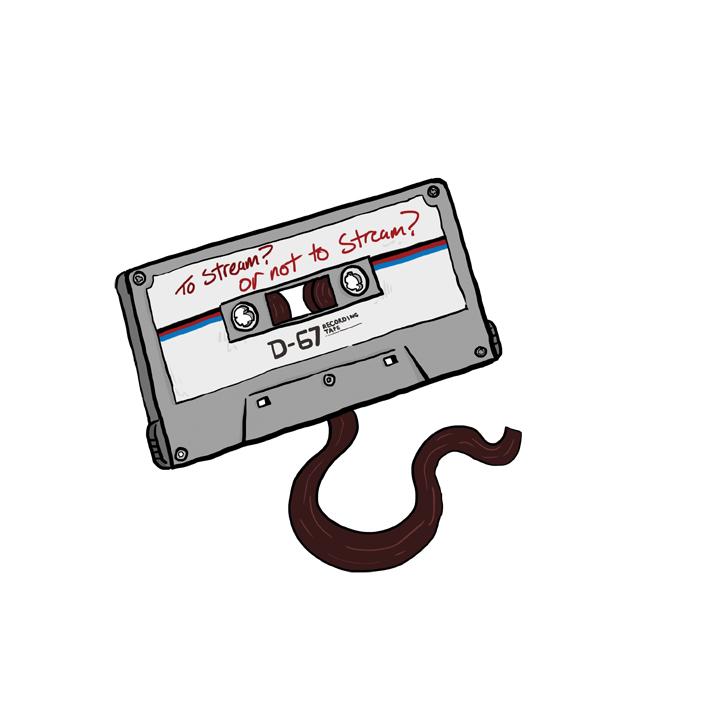I spend an embarrassingly large amount of my life with my headphones on, or getting knocked around at a local concert venue. Like so many teenagers, music and the culture that surrounds it is a way I’ve been able to define myself during high school.
But our listening options don’t resemble the graduating class of 1960 or even the class of 2000. In 2016 we have an enormously overwhelming field of choices when it comes to the way we hear our tunes. Spotify, Soundcloud, 8tracks, Tidal, and Apple Music have all sprung up just in the past decade. The convenience, immediateness, and relative cheapness of these various services are incredibly tempting, but I’ve always wondered what exactly the trade off is—and where does the money go?
The shelves of my cluttered bedroom are packed with records, messy stacks of burned CDs, and cardboard boxes of cassette tapes with handwritten tracklists. Does ignoring these gems and instead shuffling “Sad Lo-Fi Supermix” on Spotify make me a bad fan? Will my physical music collection one day collect dust and end up in a Goodwill storage facility in Daly City? Will I become solely responsible for the total collapse of the tape industry? These are questions I legitimately ask myself as I effortlessly drag hundreds of singles into uncreatively titled digital folders. I feel disloyal.
According to a study published by The Guardian in 2015, artist revenue is $.0001 per song stream on Spotify, $.0007 on Tidal, $.69 for a single track sale on iTunes, $8.50 per bandcamp album download, and $2.76 for a label-distributed CD. I know that that seems like just a jumble of very small numbers, but in general it reveals that streaming services don’t pay artists the same way that physical or even digital purchasing does. Spotify, seemingly the most popular streaming site among Tam students, costs $9.99 per month. A cassette costs around $5, a CD around $10, and a new record around $20. So assuming you buy around one album a month, regardless of the physical format, you’ve already exceeded the cost of millions of digital tracks available with a single click. Streaming means less money for artists, but more money for you. However, that money is instead going to the Internet corporations that provide the music, and not directly to the music industry. It’s definitely a trade- off of some sort.
I don’t think money is the only factor in the dilemma of buying vs. digitally renting music. Maybe I’m an exceedingly material person, or maybe I spend too much time watching ‘70s high school dramas, but there’s something sort of special about taking a record out of sleeve or peeling back the plastic on a brand new cassette. So although physical music doesn’t win the price or convenience factors, I think there’s something to be said about the routine of record shop loitering, tape deck cleaning, and CD alphabetizing.
Another significant factor to consider is whether listening to music on either format leads to the discovery of other arguably enjoyable music. Spotify’s “recommendations for you” will never quite live up to a heartfelt suggestion from your local record store clerk or the first track of your friends’ mix CD, but to be completely honest sometimes it’s kind of spot on. As much as it makes me feel like simply a statistic whose interests can be carefully calculated based off the embarrassingly high number of times I listened to Weezer’s “Buddy Holly” in the past three days, sometimes they pick real treasures.
As much as I wish I could convince myself to delete my Spotify account and spend my next paycheck exclusively on April 16’s Record Store Day releases, something inside me feels like I’d be missing out on the endless void of Internet music. We can all recognize the enormous upside for artists: it’s just as easy to upload a song as it is to download it. Instead of needing a record contract and a PR team, all you really need is a Soundcloud account and an empty garage or bedroom.
I don’t think the trend of streaming is going anywhere; Spotify has over 75 million users. But I also don’t think it’s necessarily evil to buy in. Just like everything else in our lives, it makes sense to weigh the pros and cons and not let pure convenience completely sway our actions. If I really love an album that I discover on “Rainy Garage Rock Playlist” I’ll probably end up buying the record too. So I guess it doesn’t really need to be an either or situation. I don’t think I’ll ever part with my needlessly large shoeboxes full of cassettes, but I also don’t see myself canceling my Spotify subscription anytime soon.


